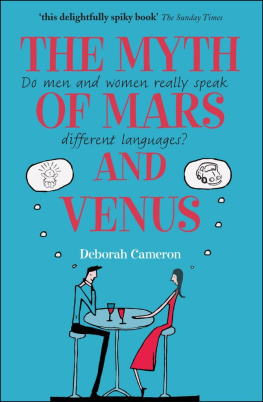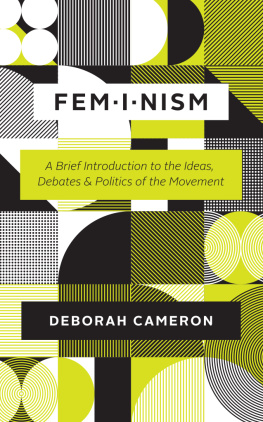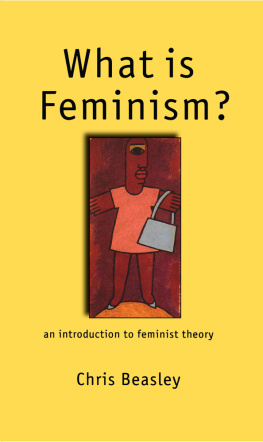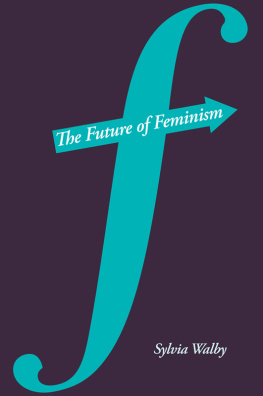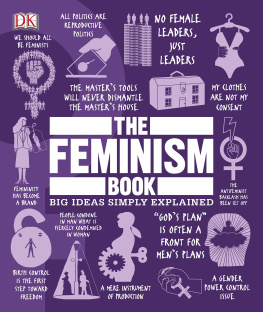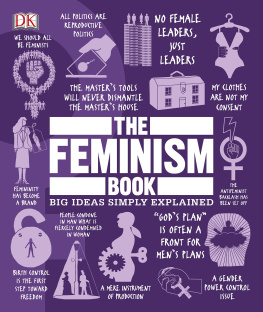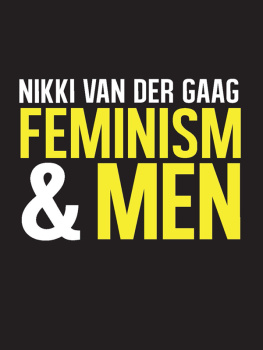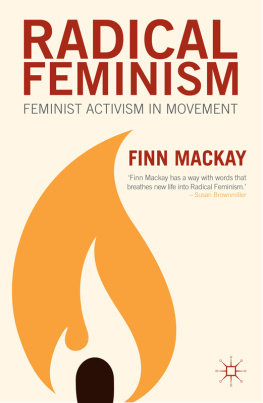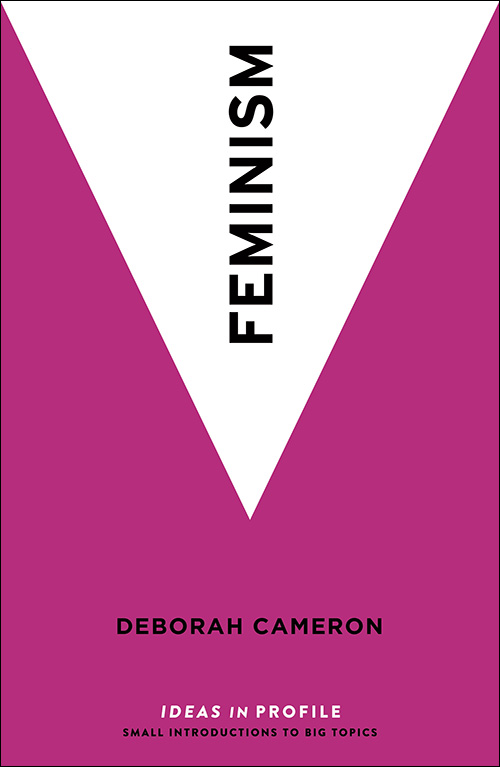FEMINISM
Deborah Cameron is the Rupert Murdoch Professor of Language and Communication at Worcester College, Oxford.

ALSO BY DEBORAH CAMERON
The Myth of Mars and Venus: Do Men and Women Really Speak Different Languages?
Language: a feminist guide, a blog, can be found at
www.debuk.wordpress.com
FEMINISM
DEBORAH CAMERON

First published in Great Britain in 2018 by
PROFILE BOOKS LTD
3 Holford Yard
Bevin Way
London WC1X 9HD
www.profilebooks.com
Copyright Deborah Cameron 2018
The moral right of the author has been asserted.
All rights reserved. Without limiting the rights under copyright reserved above, no part of this publication may be reproduced, stored or introduced into a retrieval system, or transmitted, in any form or by any means (electronic, mechanical, photocopying, recording or otherwise), without the prior written permission of both the copyright holder and the publisher of this book.
All reasonable efforts have been made to obtain copyright permissions where required. Any omissions and errors of attribution are unintentional and will, if notified in writing to the publisher, be corrected in future printings.
A CIP catalogue record for this book is available from the British Library.
eISBN 978 1 78283 352 9
CONTENTS
INTRODUCTION
We should all be feminists, proclaimed the writer Chimamanda Ngozi Adichie in her celebrated 2014 essay of that name. But a survey conducted in Britain a year later by the polling organisation YouGov found that many women were not so sure. Most agreed that feminism was still needed, but around half said they would not call themselves feminists, while one in five regarded the word as an insult.
This ambivalence is nothing new. In 1938 the writer Dorothy L. Sayers gave a lecture to a womens society entitled Are women human? She began with this disclaimer:
Your Secretary made the suggestion that she thought I must be interested in the feminist movement. I replied a little irritably, I am afraid that I was not sure I wanted to identify myself, as the phrase goes, with feminism
This sentiment was common enough at the time to prompt a contemporary of Sayers, the novelist Winifred Holtby, to ask: Why, in 1934, are women themselves so often the first to repudiate the movements of the past one hundred and fifty years, which gained for them at least the foundations of political, economic, educational and moral equality?
Then, as now, one reason for womens reluctance to call themselves feminists was their awareness of the negative stereotype associated with the label: feminist has a long history of being used to disparage women as dour, unfeminine man-haters. In addition, Sayers was writing in the period immediately after women in Britain had gained the right to vote on the same terms as men. Feminism had come to be perceived as old-fashioned and irrelevant, with nothing to say to the post-suffrage generation. (Something similar would happen again 50 years later, as young women in the 1980s and 1990s rejected their mothers Womens Lib, and media commentators proclaimed the advent of the post-feminist era.)
But another answer to Winifred Holtbys question might be that attitudes to feminism tend to vary depending on what feminism is taken to mean. When people use the word feminism, they may be talking about any or all of the following:
Feminism as an idea: as Marie Shear once put it, the radical notion that women are people.
Feminism as a collective political project: in the words of bell hooks, a movement to end sexism, sexist exploitation and oppression.
Feminism as an intellectual framework: what the philosopher Nancy Hartsock described as a mode of analysis a way of asking questions and searching for answers.
These different senses have different histories, and the way they fit together is complicated.
Feminism as an idea is much older than the political movement. In Europe, the beginnings of political feminism are usually located in the late eighteenth century; but a tradition of writing in which women defended their sex against unjust vilification had existed for several centuries before that. The text which inaugurated this tradition was Christine de Pizans The Book of the City of Ladies, written by an educated secular woman in France at the beginning of the fifteenth century. This book made a systematic attempt to rebut the misogynistic arguments about women put forward by male authorities, arguing that the worth of a person does not lie in the body according to the sex, but in the perfection of conduct and virtues. Over the next 400 years, other texts making similar arguments appeared in various parts of Europe. Their authors were relatively few in number, were not part of any collective movement, and did not call themselves feminists (that word did not come into use until the nineteenth century). But they clearly subscribed to the radical notion that women are people. It has been argued that by criticising the masculist bias of what passed, in their time, for knowledge about women, they became, in effect, the first feminist theorists.
Dorothy Sayers also believed that women are people. A woman, she wrote, is just as much an ordinary human being as a man, with the same individual preferences, and with just as much right to the tastes and preferences of an individual. But that belief was what made Sayers reluctant to embrace feminism as an organised political movement. What is repugnant to every human being, she went on, is to be reckoned always as a member of a class and not as an individual person. This is the paradox at the heart of feminist politics: in order to assert that they are people, just as men are, women must unite on the basis of being women. And since women are a very large, internally diverse group, it has always been difficult to unite them. Feminists may be united in their support for abstract ideals like freedom, equality and justice, but they have rarely agreed about what those ideals entail in concrete reality. Historians note that feminism has only ever commanded mass support when its political goals were compatible with many different beliefs and interests.
The movement for womens suffrage, which began in the nineteenth century and peaked in the early twentieth, is a case in point. Two of the central arguments deployed by campaigners rested on different and theoretically incompatible views about the nature and social role of women. One view emphasised womens similarity to men in order to argue that they deserved the same political rights, while the other emphasised womens difference from men, arguing that womens distinctive concerns could not be adequately represented by an all-male electorate. The movements objective gaining political representation for women also brought together people whose other interests and allegiances were not just different, but in some cases directly opposed. For instance, in the US there were Black women whose support for the suffragist cause reflected the belief that womens enfranchisement would advance the struggle for racial justice; conversely, there were white feminists who courted southern segregationists by using the racist argument that enfranchising white women would bolster white supremacy. In Britain, where suffrage campaigners included supporters of the Conservative, Liberal and Radical parties, Conservative women sometimes used the argument that women from the educated and propertied classes had a better claim to the vote than working-class men; socialists by contrast favoured enfranchising all women, as well as all men, since that would strengthen the position of the working class as a whole.


